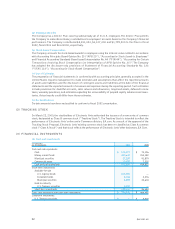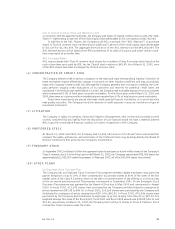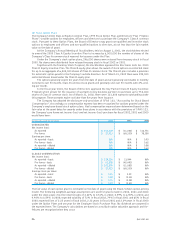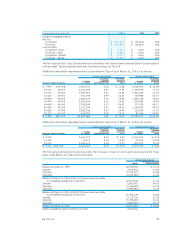Electronic Arts 2002 Annual Report Download - page 52
Download and view the complete annual report
Please find page 52 of the 2002 Electronic Arts annual report below. You can navigate through the pages in the report by either clicking on the pages listed below, or by using the keyword search tool below to find specific information within the annual report.
(d) Sales Returns and Other Reserves
The Company estimates potential future product returns and price protection related to current period
product revenue.The Company analyzes historical returns, current sell through of distributor and retailer
inventory of the Company’s products, current trends in the video game market and the overall economy,
changes in customer demand and acceptance of the Company’s products and other related factors when
evaluating the adequacy of the sales returns and price protection allowances. In addition, the Company
monitors and manages the volume of sales to retailers and distributors and their inventories as substantial
overstocking in the distribution channel can result in high returns or the requirement for substantial price
protection in subsequent periods.
Similarly, the Company must use significant judgment and make estimates in connection with estab-
lishing allowances for doubtful accounts in any accounting period. The Company analyzes customer
concentrations, customer credit-worthiness and current economic trends when evaluating the adequacy of
the allowance for doubtful accounts.
(e) Cash and Investments
Cash equivalents consist of highly liquid investments with insignificant rate risk and with maturities of three
months or less at the date of purchase. Short-term investments include securities with maturities greater
than three months and less than one year, except for certain investments with stated maturities greater than
one year. Long-term investments consist of securities with maturities greater than one year.
The Company accounts for investments under Statement of Financial Accounting Standards No. 115
(“SFAS 115”),
“Accounting for Certain Investments in Debt and Equity Securities”
.The Company’s policy
is to protect the value of its investment portfolio and to minimize principal risk by earning returns based on
current interest rates. Management determines the appropriate classification of its debt and equity securi-
ties at the time of purchase and reevaluates such designation as of each balance sheet date. Debt securities
are classified as held-to-maturity when the Company has the positive intent and ability to hold the securities
to maturity. Securities classified as held-to-maturity are carried at amortized cost, which is adjusted for
amortization of premiums and accretion of discounts to maturity. Such amortization is included in interest
income. Debt securities, not classified as held-to-maturity, are classified as available-for-sale and are stated
at fair value. Securities sold are based on the specific identification method.
(f) Prepaid Royalties
Prepaid royalties consist primarily of prepayments for manufacturing royalties, co-publishing and/or distri-
bution affiliates and license fees paid to celebrities, professional sports organizations and other
organizations for use of their trade name and content. Also included in prepaid royalties are prepayments
made to independent software developers under development arrangements that have alternative future
uses. Prepaid royalties are expensed at the contractual or effective royalty rate as cost of goods sold based
on actual net product sales. Management evaluates the future realization of prepaid royalties quarterly and
charges to research and development expense any amounts that management deems unlikely to be realized
through product sales. Royalty advances are classified as current and non-current assets based upon esti-
mated net product sales for the following year.The current portion of prepaid royalties, included in other
current assets, was $65,484,000 and $46,264,000 at March 31, 2002 and 2001, respectively.The long-
term portion of prepaid royalties, included in other assets, was $1,164,000 and $9,664,000 at March 31,
2002 and 2001, respectively.
(g) Software Development Costs
Research and development costs, which consist primarily of software development costs, are expensed as
incurred. Statement of Financial Accounting Standards No. 86 (“SFAS 86”),
“Accounting for the Cost of
Computer Software to be Sold, Leased, or Otherwise Marketed”
,provides for the capitalization of certain
software development costs incurred after technological feasibility of the software is established or for
development costs that have alternative future uses. Under the Company’s current practice of developing
new products, the technological feasibility of the underlying software is not established until substantially
all product development is complete, which generally includes the development of a working model.The
software development costs that have been capitalized to date have been insignificant.
EA 2002 AR
48
























